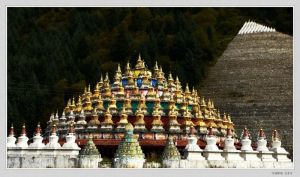Panchen Lama
Jump to navigation
Jump to search


Lobsang Choekyi Gyaltse]]n as the Panchen (Great Scholar) Lama of Tashilhunpo Monastery (Bkra-shis Lhung-po) in Shigatse (Gzhis-ka rtse). With this appointment, Lobsang Choekyi Gyaltsen's three previous incarnations were posthumously recognised as Panchen Lamas. The Fifth Dalai Lama also recognized Panchen Lobsang Yeshe (Blo-bzang Ye-shes) as the Fifth Panchen Lama. The Seventh Dalai Lama recognized the Sixth Panchen Lama, who in turn recognized the Eighth Dalai Lama. Similarly, the Eighth Dalai Lama recognised the Seventh Panchen Lama. Choekyi Gyaltsen, the 10th Panchen Lama, became the most important political and religious figure in Tibet following the 14th Dalai Lama's escape to India in 1959. In April, 1959 the 10th Panchen Lama sent a telegram to Beijing expressing his support for suppressing the 1959 rebellion. “He also called on Tibetans to support the Chinese government.” However, in 1964, he was imprisoned. His situation worsened when the Cultural Revolution began. The Chinese dissident Wei Jingsheng wrote in March 1979 a letter denouncing the inhumane conditions of the Chinese Qincheng Prison where the late Panchen Lama was imprisoned. In October 1977, he was released but held under house arrest in 1982. In 1979, he married a Han Chinese woman and in 1983 they had a daughter, which is not unusual as several Gelug high lamas (Gelek Rinpoche in the US and Dagyab Rinpoche in Germany, among others) have chosen a layman's lifestyle, both inside China and in exile; also, the 6th Dalai Lama, also a Gelugpa, renounced his monk vows and led not only a layman's but a playboy's lifestyle, but still is highly revered by Tibetans. In 1989, the [[10th Panchen Lama]] died suddenly in Shigatse, Tibet, at the age of 51, shortly after giving a speech critical of the Chinese neglect for the religion and culture of the Tibetans. His daughter, now a young woman, is Yabshi Pan Rinzinwangmo, better known as "Renji".
Lineage of the Panchen Lamas
In the lineage of the Tibetan Panchen Lamas there were considered to be four Indian and three Tibetan incarnations of Amitabha Buddha before Khedrup Gelek Pelzang, who is recognised as the 1st Panchen Lama. The lineage starts with Subhuti, one of the original disciples of Gautama Buddha. Gö Lotsawa is considered to be the first Tibetan incarnation of Amitabha Buddha in this line. The Panchen Lama's political significance Monastic figures had historically held important roles in the social and political makeup of Tibet, and though these roles have diminished since 1959, many Tibetans continue to regard the Panchen Lama as a significant political, as well as spiritual figure due to the role he traditionally plays in selecting the next Dalai Lama. The political significance of the role is also utilised by the Chinese state. Tibet support groups have argued that the Chinese government seeks to install its own choice of Dalai Lama when Tenzin Gyatso, the current Dalai Lamas and that for this reason the Dalai Lama's choice of Gedhun Choekyi Nyima went missing at the age of six, to be replaced by the Chinese state's choice, Gyancain Norbu. If this tactic is accurate, the announcement made by the Dalai Lama on 10 March 2011 that he will step down from his political role may result in a change of policy regarding the two disputed candidates.List of Panchen Lamas
| Name | Life span | |
|---|---|---|
| 1. | Khedrup Je | 1385–1438 |
| 2. | Sönam Choklang | 1438–1505 |
| 3. | Ensapa Lobsang Döndrup | 1505–1568 |
| 4. | Lobsang Chökyi Gyalsten | 1570–1662 |
| 5. | Lobsang Yeshe | 1663–1737 |
| 6. | Lobsang Palden Yeshe | 1738–1780 |
| 7. | Palden Tenpai Nyima | 1782–1853 |
| 8. | Tenpai Wangchuk | 1855?–1882 |
| 9. | Thubten Chökyi Nyima | 1883–1937 |
| 10. | Lobsang Trinley Lhündrub Chökyi Gyaltsen | 1938–1989 |
| 11. | Gedhun Choekyi Nyima | 1989– |
| Gyancain Norbu | 1990– |
